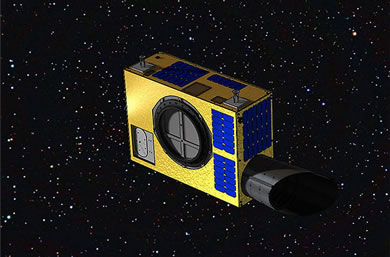NEOSSat
High above our heads tens of thousands of objects silently orbit the Earth. Several hundred of these objects are currently operational, watching the Earth's weather, monitoring the environment, ensuring communications to remote locations, helping to guide traffic, and playing hundreds of other civilian and military crucial roles that often go unheralded. The rest of the objects are debris - junk - and they threaten the satellites that play these important roles in society.
Researchers at RMC have - since 1991 - conducted research that has played a leading role in allowing Canada to help keep track of these Earth-orbiting objects, both operational and debris, Canadian and international. Using a small optical telescope located on the RMC campus, the researchers in the Space Surveillance Research and Analysis Laboratory (SSRAL) in the Department of Physics, blazed the pathway that has led the Canadian Forces to field a small network of similar telescopes around Canada.
 Their work has also led to DND developing two satellites that will track these objects and which are expected to be launched in 2012. The first satellite, called Sapphire, is an operational spacecraft that will contribute to NORAD's mission to keep track of objects passing through space. The second spacecraft, called the Near Earth Orbit Surveillance Satellite (NEOSSat), is being developed jointly by Defence Research and Development Canada (DRDC) and the Canadian Space Agency (CSA), and has a research mandate; RMC researchers are playing a central role in the science that will result.
Their work has also led to DND developing two satellites that will track these objects and which are expected to be launched in 2012. The first satellite, called Sapphire, is an operational spacecraft that will contribute to NORAD's mission to keep track of objects passing through space. The second spacecraft, called the Near Earth Orbit Surveillance Satellite (NEOSSat), is being developed jointly by Defence Research and Development Canada (DRDC) and the Canadian Space Agency (CSA), and has a research mandate; RMC researchers are playing a central role in the science that will result.
NEOSSat has two science missions. The first, led by Dr. Alan Hildebrand from the University of Calgary, is devoted to detecting and tracking asteroids that cross Earth's but which usually are in the daytime sky, making them difficult to detect from the ground. The second mission is called the High Earth Orbit Surveillance System (HEOSS), led by Dr. Brad Wallace at DRDC, will conduct research related to the detection and tracking Earth orbiting objects.
To support the HEOSS experiments, RMC researchers are acquiring data and developing techniques that will later be used on NEOSSat. The focus of this research is photometry, both monochrome and colour. Temporal photometric signatures will be used to characterize space objects and determine the spin axes of tumbling satellites. Spectral signatures will be used to characterize satellites to contribute to accurate tracking and identification, and to better understand the weathering effects of the space environment on the materials used to construct NEOSSat.
For further information about NEOSSat and the related research at RMC, contact:
- Mr. Phil Somers: Phil.Somers@rmc-cmr.ca
For more general information on NEOSSat, please see:
Canadian Space Agency NEOSSat web-page
Comments
Comments or suggestions are welcomed at: bryce.bennett@rmc-cmr.ca